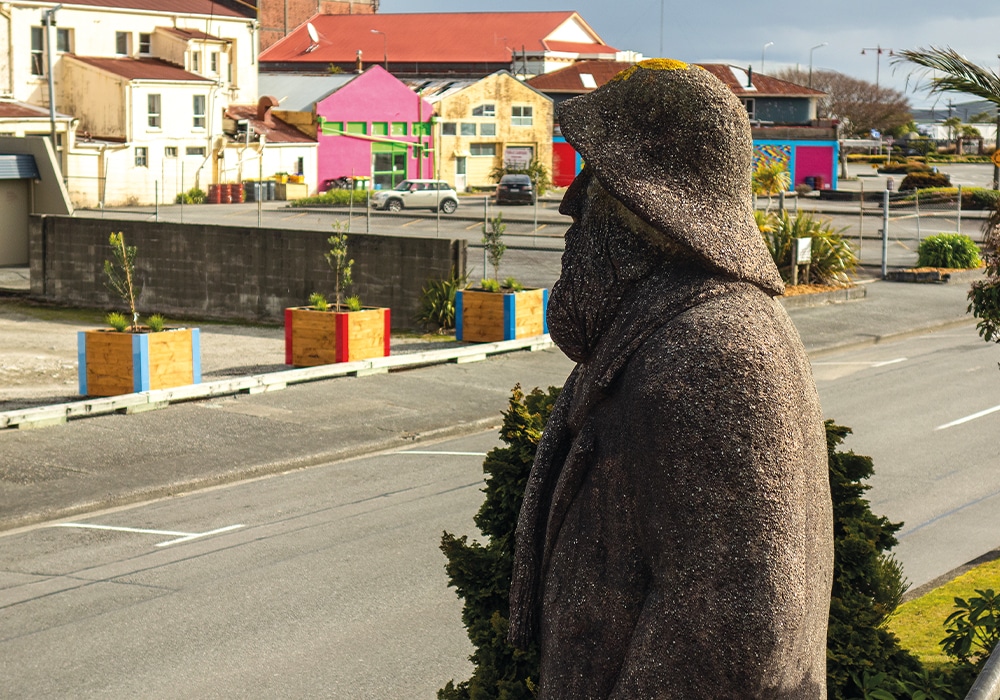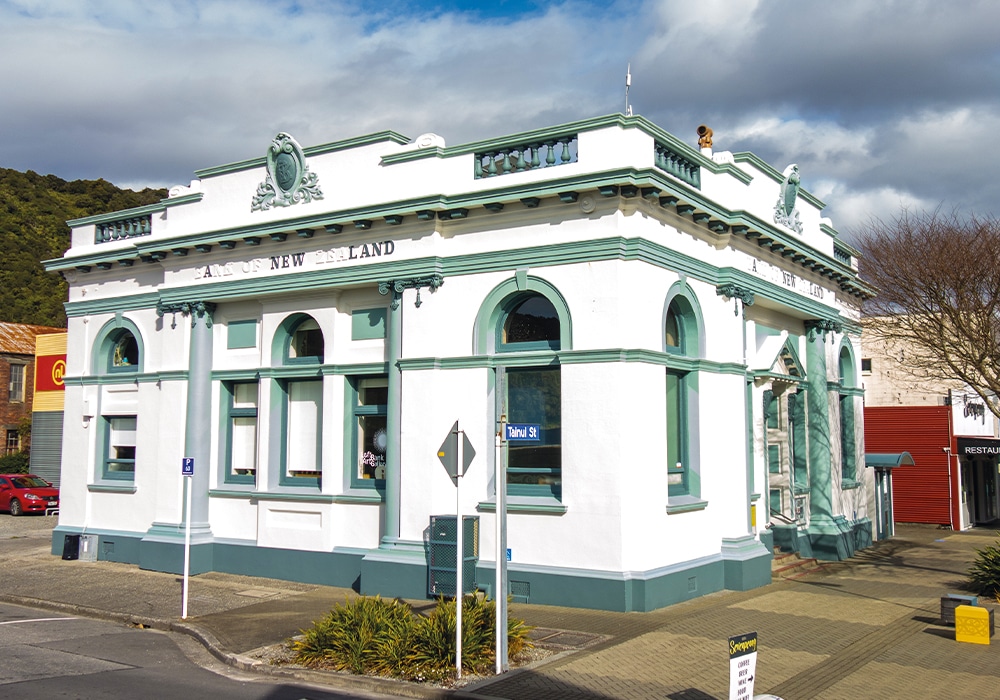Paul Owen reflects on the wild history and deep resilience of Greymouth, the town with a dramatic past that’s doing its best to become a 21st century city.
Most towns in New Zealand have monuments dedicated to those who fought in overseas wars, and Greymouth contributed the flower of its manhood to those events just like all the rest. However, you’ll find plenty of other memorials dotted around the town located precariously at the mouth of the flood-prone Grey River, because its geographical position made it a vital port for the coal industry of the Grey River valley, and the coal won from the surrounding hills proved so energy dense that it made the warships of the Royal Navy steam faster.
Many miners would pay the ultimate price during the extraction of that ‘black gold’ in a series of underground explosions of methane gas that would take out entire shifts of men, from the 65 lost in the Brunner mine in 1896 to the far more recent loss of 29 at Pike River in 2010. Add the 19 killed at the Strongman mine in 1967, and all those who drowned in 22 shipwrecks while crossing the Grey River bar, and you get the idea that Greymouth, as the export hub of that power-packed precious mineral, has survived the last 150 years as some kind of occupational health red zone.
It’s not just the mining or the wild capsizes while crossing the bar that kill. Even just going for a cooling swim in the Tasman Sea at Port Elizabeth, near Greymouth, on a hot February day can prove hazardous, as six townsfolk found to their peril, when a sudden rip swept them to their deaths in 1922.
Perhaps the most poignant memorial of them all, therefore, is the giant concrete statue of a well-weathered civil defence volunteer who stands on the recently raised flood bank of the river and surveys the town. He’s dedicated “To those who help others” in disasters. Not just mining tragedies – any kind of disaster. As the ‘shipwreck capital of New Zealand’ and arguably the South Island’s most flooded town, Greymouth has had so many. And yet it endures.
It’s the stoicism displayed in that statue by local sculptor, Stephan Newby, that makes Greymouth such a fascinating place to visit. These days, the town is reeling from yet another roadblock in its glacial progress towards city status. It’s a double whammy – the wane of tourism during the pandemic that has coincided with new earthquake regulations that require most of the town’s historic riverside buildings to be expensively strengthened or demolished. The last time the town faced such a stern challenge to its viability was in September 1988, when the river burst through its banks and flooded the town to second-storey level. It was the second time that year that ‘the town turned into a lake’, and hundreds of its citizens needed to be evacuated.
Dramatic History
Until the huge flood walls – which were constructed either side of the river, higher than any town building besides the multi-level Copthorne Hotel – were completed in 1990, such events occurred with almost clockwork regularity. Had the port town not been so important to the dominant sea power of the Royal Navy, it’s doubtful whether Greymouth would have survived the aftermath of the big floods of 1872, 1887, and 1905. During World War One, the first secretary of the Navy, Winston Churchill, and Lord Kitchener both urged that the stalled construction of a railway link between Greymouth and Christchurch be resolved for fear that the German Navy would blockade Greymouth and deny the British Empire access to the high-quality Grey Valley coal that enabled its dreadnought battleships to travel two knots faster. Come hell or high water, such were the nautical and naval advantages of the coal that it was too precious to leave in the ground. It was the enriched uranium of the day.
The rains didn’t stop once New Zealand reached dominion status, and there’s a degree of resignation to the names that Greymouth’s citizens gave to subsequent floods. When the Grey River again entered the town in 1936 bringing with it tonnes of silt and ballast from the undermined new railway, along with thousands of dead stock from Grey Valley farms, the locals named it ‘the biggest since 1887 flood’.
The 1977 event that would leave water marks on some houses at five-foot level on the walls was called ‘the biggest since 1936 flood’. When the Grey again rushed into the town in May 1988, it was with such a forceful surge that the coasters simply called it “The Big One”. So, what did they name the flood that came through just four months later in September 1988? ‘The Biggest One.’
Millions of dollars were then spent to create the walls that now protect the town, and they’re substantial enough to wonder whether any part of the Netherlands has dykes of such impressive height. The river’s confining walls are a nice place to stroll or cycle along. There’s the official start of the West Coast Wilderness Cycle Trail just to the east of Greymouth’s intriguing transparent clock tower, where you can admire the workings of what used to be the timepiece of the now defunct Post Office building.
The river is relatively calm at this point, but as it travels towards the open sea the surf crashing into the bar can create challenges for local fishermen venturing out during hoki season. You have to admire their courage as their vessels ride out the turbulent waves, bobbing like little rubber ducks in Tangaroa’s own bathtub. You get a good view of the town from the wall on the southern side of the river and can scope out which establishments to visit. For me, the stars are the small family businesses that are under increasing pressure to survive in our post-pandemic world.
These mostly inhabit the older buildings of the town, many of which date back to either the Victorian era of the West Coast gold rushes, or the art deco rebuild that followed the 1936 flood. The Regent Theatre, among the latter, is a vibrant central meeting place for the townsfolk, whether it’s to catch a movie, join the crochet group in the café, or enjoy a concert by the latest Abba revival band or the widely-travelled famous Dutch violinist, Andrè Rieu.
Alf Harrison Menswear on Tainui Street has been there for 97 years, outlasting its namesake founder and now being run by retired traffic cop, John. When John wrote a speeding ticket, he probably did it with a smile and wished you all the best for the rest of the day, such is the friendly service he gives to customers in his shop. He’s quick to whip out his tape measure and then steer you directly to the clothes that are going to fit best. You won’t receive such service at Farmers or The Warehouse, yet John’s prices are comparable to those of such big-chain department stores. The smile comes free.
Opposite the former Bank of New Zealand that’s now an art gallery, you’ll find Shades of Jade in one of the tidier old buildings of the Greymouth CBD. This pounamu emporium is owned and operated by Catherine and Warren Woollet, and they have an intimate knowledge of the locally-sourced greenstone that principal carver Jeremy Dalzell shapes into fine jewellery for the shop. Many of the pieces are made of Marsden Flower Jade, a rare type of greenstone that is only found in the nearby Taramakau River and its tributaries, that’s notable for its streaks of orange and gold across cloud-like patterns of light and dark greenstone. Catherine was wearing some beautiful translucent earrings made of rare white jade when we visited, sourced from a stone found in the Spoon River, South Westland, by Ken Landau several decades ago and still providing raw material for the store. It’s this knowledge of the stone’s journey from source river to finished jewellery that makes buying pounamu from here so unique.
Larger pieces of raw pounamu can be found all over the town, many marking significant events in the rich history of Greymouth. Perhaps the most significant is the large lump of greenstone that remembers the purchase of virtually the entire west coast of the South Island back in 1860. Crown agent, James Mackay, was able to persuade 14 chiefs of Poutini Ngāi Tahu to relinquish their ownership of 7.5 million acres of land, stretching from Kahurangi Point near Golden Bay to Milford Sound. The price? 300 gold sovereigns.

the 1860 Westland land deal
It was an act of great generosity on the part of those Māori, who continued to welcome the huge influx of gold seeking miners that the land purchase triggered, and actively showed these diggers where they could find the precious mineral. Vitally, pockets of land that were important to Māori, amounting to nearly 7000 acres, were somehow left out of the Westland purchase.
One of those pockets was Mawhera Pa, where the town of Greymouth now stands, next to the gap in the hills created when the giant demi-god, Tu, wriggled his thighs and released the pent-up waters of the Grey River.
Five Must-Dos in Greymouth
1. Catch the Trans-Alpine Express to any of the stops from Greymouth – Lake Brunner, Arthurs Pass, Darfield, or all the way to Christchurch if that’s your wish.
2. Cycle along sections of the West Coast Wilderness Trail towards Hokitika.
3. Read all the history depicted in the mural on the wall of the old Greymouth Evening Star newspaper building.
4. Drive up the valley to the memorial for the Brunner mine disaster and on to Blackball, site of a historic miners strike in 1908 that laid the foundations for socialism in New Zealand.
5. Take a tour of the historic Monteith’s Brewery. Tours begin every day at 4pm.
Places to Stay
• The freedom camping area at Point Elizabeth gives great views of the Grey River bar and has clean, well-maintained toilets.
• Railway Hotel – for those who want a clean genuine NZ hotel experience from the 1960s at a budget price.
• Copthorne Hotel – multiple levels allow spectacular views but expect only three-star accommodation.
• Global Village – funky backpacker accommodation handy to Anzac Park
• Formerly the Blackball Hilton – 20km drive away from Greymouth but still one of the best places to stay in the Grey River valley.














